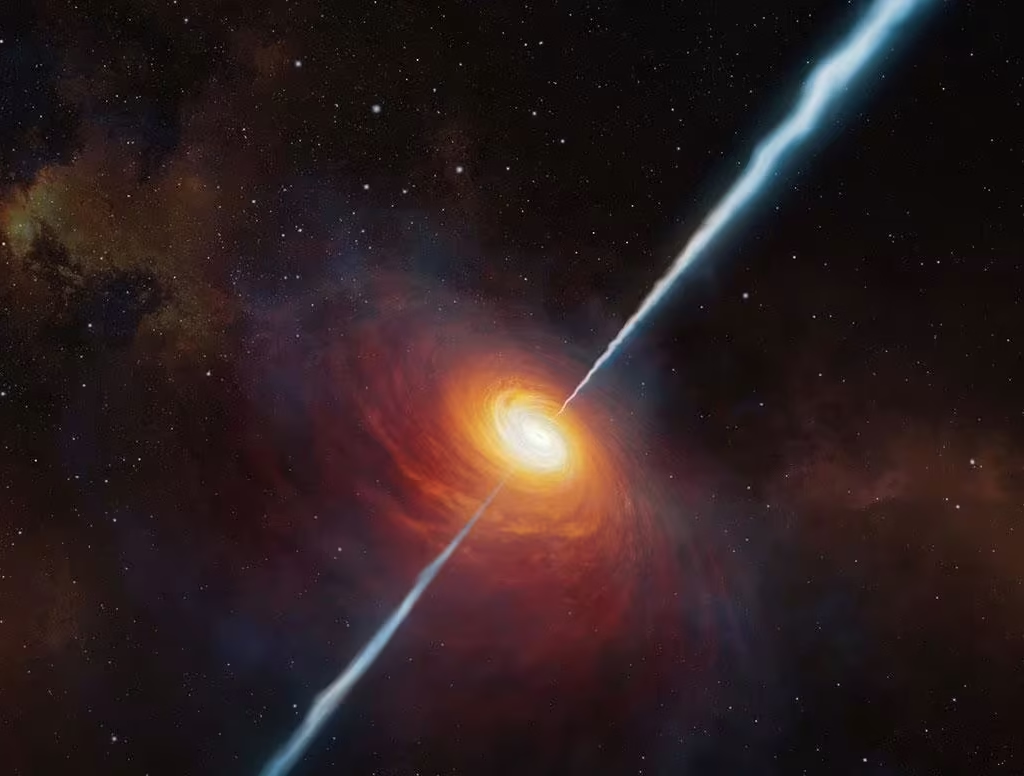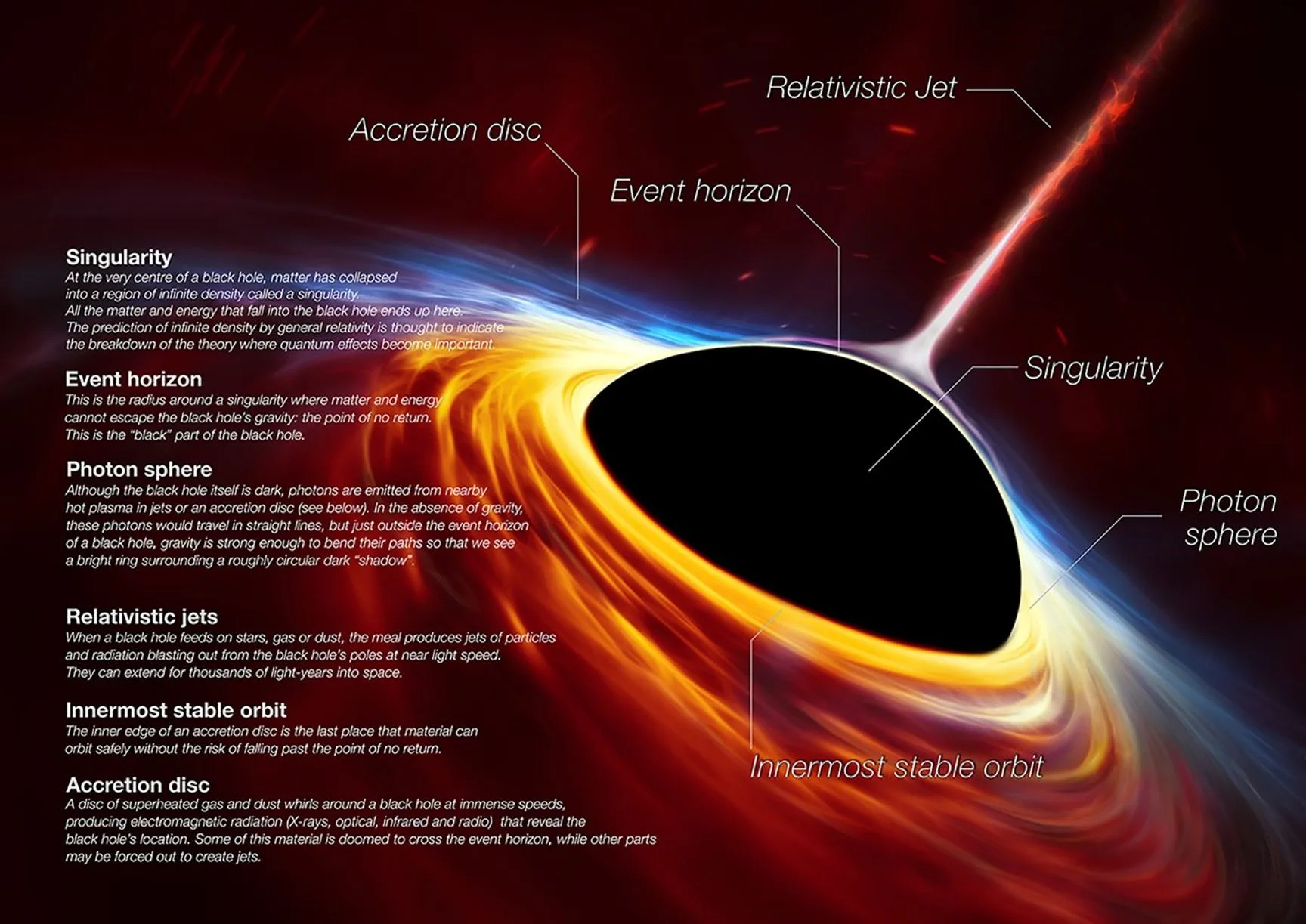The color of a black hole is one of the most intriguing questions in astrophysics. Can something that absorbs all light actually have a color? While black holes themselves emit no light, the environment around them offers a dazzling display of cosmic phenomena but first thought come in our mind what is black hole?
A black hole is an incredibly dense region in space where gravity is so strong that nothing, not even light, can escape from it. This gravitational pull is so powerful because a significant amount of matter has been compressed into a very small area. Black holes are one of the most mysterious and extreme objects in the universe.
Here’s a breakdown of what makes a black hole:
Key Features of a Black Hole:
- Event Horizon:
The event horizon is the “point of no return” around a black hole. Once something crosses this boundary, it cannot escape. This is where the gravitational pull becomes so intense that even light, which moves at the fastest speed possible, cannot break free. Everything inside the event horizon is beyond our observational reach. - Singularity:
At the very center of a black hole lies the singularity, where gravity is thought to be infinitely strong, and the laws of physics as we know them break down. The singularity is the point where all the mass of the black hole is concentrated, making it a mathematical point with no volume, but an immense gravitational force. - Accretion Disk:
Around many black holes, especially active ones, there’s a disk of gas, dust, and debris that spirals into the black hole. This disk is heated to extremely high temperatures as it moves inward due to friction, emitting vast amounts of radiation, often in the form of X-rays. This glow can be observed by telescopes, allowing scientists to infer the presence of a black hole.

Copyright ESO/M. Kornmesser
Now Let’s dive into 10 fascinating truths that help explain what a black hole really looks like—and what we mean by its “color.”
1. The Black Hole Itself is Truly Black
The term black hole arises from the fact that no light can escape from it. This makes the black hole “black” in the most literal sense. The gravity near the black hole is so intense that even light cannot escape its pull, rendering the event horizon completely dark. If you could hypothetically approach a black hole (and survive the journey), you wouldn’t see any light coming from the black hole itself. It would be a vast region of emptiness and darkness.
This is why black holes are often depicted as pitch-black holes in space. Despite this, the area surrounding the black hole can glow intensely, offering us indirect ways to observe them.
2. The Event Horizon’s Shadow: A Dark Circle
While black holes are known for being invisible, we can detect their presence by observing the shadow they cast against the surrounding light. This shadow is the most visible feature of a black hole, albeit a dark one. The event horizon marks the point of no return, beyond which nothing, not even light, can escape. The shadow is the result of light being bent around the black hole, and in 2019, the Event Horizon Telescope (EHT) released the first-ever image of a black hole’s shadow, revealing a dark circle surrounded by a glowing ring.
This event marked a significant breakthrough in astrophysics, as it provided the first direct visual evidence of a black hole, proving that even objects beyond our light-year reach can be observed through advanced imaging technology.
3. Accretion Disks: The Color of Light Around Black Holes
While black holes themselves do not emit light, they are often surrounded by an accretion disk—a swirling mass of gas and dust spiraling into the black hole. As this material is pulled into the gravitational abyss, friction causes it to heat up, emitting a tremendous amount of light. The color of this light is primarily determined by the temperature of the gas, with hotter regions glowing in blue or white, and cooler areas shining yellow or red.
The accretion disk often emits in the X-ray and ultraviolet spectrum, which are not visible to the human eye, but when these wavelengths are translated into visible light, they appear in bright, intense colors. The glowing colors surrounding the black hole give the illusion that the black hole is “shining,” but this is due to the material in the disk rather than the black hole itself.
4. Relativistic Doppler Effect: A Bright Asymmetry
A black hole’s accretion disk does not glow uniformly. Due to the relativistic Doppler effect, the light emitted from the side of the disk moving toward the observer appears brighter and bluer, while the light from the side moving away from the observer is redder and dimmer. This effect occurs because the material closest to the black hole is moving at speeds approaching the speed of light.
This creates a striking asymmetry in the way the black hole appears, with one side of the glowing disk appearing much brighter than the other. The variation in brightness helps astronomers study the motion and behavior of matter around the black hole, as well as gain insight into the effects of extreme gravitational forces.
5. Gravitational Lensing: Light Warped Around the Black Hole
Black holes are not only powerful enough to consume light—they can also bend and warp light due to their intense gravitational field. This effect, known as gravitational lensing, occurs when light from objects behind the black hole is bent around it, allowing astronomers to observe distant stars or galaxies that would otherwise be hidden.
The bending of light around a black hole can create a circular ring, known as the photon ring or Einstein ring. This phenomenon can cause the light surrounding the black hole to appear distorted, offering a unique, nearly surreal view of space around a black hole. Gravitational lensing is one of the ways scientists can study black holes, even when they cannot observe the black hole itself directly.
6. X-rays and Gamma Rays: The High-Energy Light Spectrum
In addition to visible light, black holes can emit X-rays and gamma rays. These high-energy emissions are the result of the intense gravitational forces acting on material in the accretion disk. As matter accelerates toward the black hole, it heats up to extreme temperatures, causing it to emit radiation in the form of X-rays and gamma rays.
This radiation is often captured by telescopes like NASA’s Chandra X-ray Observatory and the Fermi Gamma-ray Space Telescope. These observations allow astronomers to detect black holes in distant galaxies by identifying the high-energy radiation they emit. While we cannot see X-rays and gamma rays with the naked eye, they are crucial for understanding the energy dynamics near a black hole.
7. False Color in Black Hole Imaging
Images of black holes, such as the famous 2019 image of the M87 black hole, are often false-colored. In these images, scientists assign colors to different wavelengths of light that are not visible to the human eye. For example, the high-energy X-rays emitted by the accretion disk may be colorized in blue, while radio waves might appear in red.
This use of false color helps scientists and the public better visualize the phenomena surrounding black holes, but it is important to note that the actual colors are not visible to the naked eye. The colorized images simply represent different energies of light, allowing researchers to distinguish various features of the black hole’s environment.
8. Black Hole Jets: A Shining Paradox
One of the most fascinating and paradoxical features of black holes is the formation of relativistic jets. These are streams of highly energized particles ejected from the poles of the black hole at nearly the speed of light. These jets can extend for thousands of light-years, and although black holes are known for pulling in light, they can also produce some of the most brilliant, high-energy emissions in the universe.
These jets can appear in many colors depending on their temperature and the materials they interact with. They are often observed in the radio, X-ray, and optical spectrums. The bright emission of these jets provides astronomers with a way to study black holes, even when they are located at the centers of distant galaxies.
9. Supermassive vs. Stellar-Mass Black Holes: Different Colors
The color of light emitted around black holes can also vary depending on the size of the black hole. Supermassive black holes, found at the centers of most galaxies, can have much larger accretion disks, and their powerful gravitational forces can cause them to emit a wide range of light, from infrared to visible light to high-energy X-rays. These black holes may have bright, colorful accretion disks that emit across a broad spectrum of wavelengths.
On the other hand, stellar-mass black holes, which form from the collapse of individual stars, tend to have smaller accretion disks and may emit primarily in X-rays. As a result, the color of light surrounding a stellar-mass black hole may appear more limited in its range, with less visible light being emitted.
10. Seeing the Color of a Black Hole Up Close
If you were somehow able to approach a black hole (and survive the process), the colors you’d see would be the result of the intense energy released by the accretion disk and relativistic jets. You would witness a vibrant swirl of light around the black hole, where the brighter regions would likely appear blue or white, while cooler areas might show up in red or yellow.
However, the black hole itself would remain a dark, impenetrable region, devoid of light. The experience of viewing a black hole would be a surreal combination of light, distortion, and darkness—a truly unique cosmic phenomenon.
Conclusion: The Color of Black Holes Is More Than Meets the Eye
While the black hole itself is dark, the phenomena surrounding it—such as the accretion disk, relativistic jets, and gravitational lensing—create a dynamic, colorful environment. The color of a black hole is not the color of the hole itself, but rather the light emitted by the material it consumes and the energy it releases. Thanks to groundbreaking astronomical research and technology, we now have a better understanding of the complex and beautiful visual world of black holes.
Further Reading:
ESA – Black Holes: https://www.esa.int/Science_Exploration/Space_Science/Black_holes
NASA – Black Hole Basics: https://science.nasa.gov/astrophysics/focus-areas/black-holes
Event Horizon Telescope: https://eventhorizontelescope.org
Chandra X-ray Observatory: https://chandra.harvard.edu
Also Read
https://newsnanosecond.com/scientists-discover-color-called-olo/
References
NASA – Black Hole Basics
General information about black holes, their properties, and discovery.
Event Horizon Telescope (EHT)
The collaboration that produced the first image of a black hole (M87).
Chandra X-ray Observatory
Provides details on X-ray observations of black holes and other cosmic phenomena.
European Space Agency (ESA) – Black Holes
A comprehensive resource on black holes from the ESA.
NASA NuSTAR Mission
The NuSTAR mission detects high-energy X-ray emissions, which are crucial in studying black holes.
Harvard-Smithsonian Center for Astrophysics
A reliable source for information on astrophysics, including black holes and related phenomena.
NSF – M87 Black Hole Announcement
Original press release from the National Science Foundation about the first-ever image of a black hole.

Add a Comment